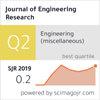Finite element analysis of motorcycle suspension system stability using different materials
IF 2.2
4区 工程技术
Q3 ENGINEERING, MULTIDISCIPLINARY
引用次数: 0
Abstract
Due to the unsuitability of conventional materials in Motorcycle Suspension Systems (McSS) for high-stress loads, their poor vibration dampening, uneven distribution of kinetic energy through the spring, and higher cost, there is a need to explore alternative materials for suspension systems. This study focuses on assessing the structural stability of the McSS using different materials. For this purpose, a three-dimensional standard helical spring suspension model is considered, incorporating four different coil spring materials: high carbon steel, titanium, beryllium copper, and nickel-cobalt-chromium alloy. The spring coil suspension body is assumed to have homogeneous and linear material properties. Boundary conditions such as single-person and two-person loads are applied to the suspension. Following this, Finite Element Analysis (FEA) is employed for all material cases to evaluate directional deformation in the y-axis and equivalent stress, and a comparison is made to analyze structural stability. The results indicate that the nickel-cobalt-chromium alloy coil spring exhibits superior performance in terms of deformation and equivalent stress compared to titanium and beryllium copper alloy. Under both load conditions, the maximum deformation of the nickel-cobalt-chromium alloy is 106% and 57% less than titanium and beryllium copper alloy, respectively. However, the deformation and von Mises stress of the nickel-cobalt-chromium alloy are nearly similar to that of steel. Therefore, nickel-cobalt-chromium alloy can serve as an alternative to titanium and beryllium copper alloy when suspension weight is not a concern. However, high carbon steel is the better choice among the four materials due to its comparatively lower weight, optimal deformation, and higher von Mises stress.
使用不同材料对摩托车悬挂系统稳定性进行有限元分析
由于传统材料在摩托车悬架系统(McSS)中不适合高应力载荷,其减振效果差,通过弹簧的动能分布不均匀,成本较高,需要探索替代材料的悬架系统。本研究的重点是评估使用不同材料的McSS的结构稳定性。为此,考虑了一个三维标准螺旋弹簧悬架模型,其中包含四种不同的螺旋弹簧材料:高碳钢,钛,铍铜和镍钴铬合金。假定弹簧卷悬体具有均匀线性的材料特性。边界条件,如单人和两人载荷应用于悬架。然后,采用有限元分析(Finite Element Analysis, FEA)对所有材料情况进行y轴方向变形和等效应力评估,并进行对比分析结构稳定性。结果表明,镍钴铬合金线圈弹簧在变形和等效应力方面优于钛和铍铜合金。在两种载荷条件下,镍钴铬合金的最大变形量分别比钛和铍铜合金小106%和57%。然而,镍钴铬合金的变形和von Mises应力几乎与钢相似。因此,镍钴铬合金可以作为钛和铍铜合金的替代品,当悬吊重量不是一个问题。而在这四种材料中,高碳钢因其相对较轻的重量、最佳的变形和较高的von Mises应力而成为较好的选择。
本文章由计算机程序翻译,如有差异,请以英文原文为准。
求助全文
约1分钟内获得全文
求助全文
来源期刊

Journal of Engineering Research
ENGINEERING, MULTIDISCIPLINARY-
CiteScore
1.60
自引率
10.00%
发文量
181
审稿时长
20 weeks
期刊介绍:
Journal of Engineering Research (JER) is a international, peer reviewed journal which publishes full length original research papers, reviews, case studies related to all areas of Engineering such as: Civil, Mechanical, Industrial, Electrical, Computer, Chemical, Petroleum, Aerospace, Architectural, Biomedical, Coastal, Environmental, Marine & Ocean, Metallurgical & Materials, software, Surveying, Systems and Manufacturing Engineering. In particular, JER focuses on innovative approaches and methods that contribute to solving the environmental and manufacturing problems, which exist primarily in the Arabian Gulf region and the Middle East countries. Kuwait University used to publish the Journal "Kuwait Journal of Science and Engineering" (ISSN: 1024-8684), which included Science and Engineering articles since 1974. In 2011 the decision was taken to split KJSE into two independent Journals - "Journal of Engineering Research "(JER) and "Kuwait Journal of Science" (KJS).
 求助内容:
求助内容: 应助结果提醒方式:
应助结果提醒方式:


